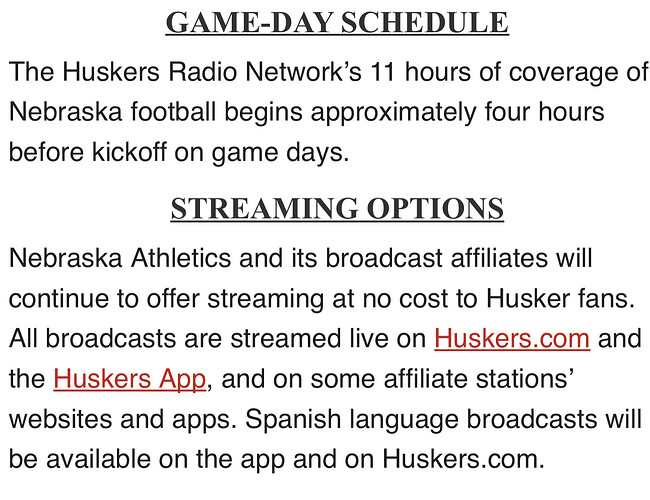I was expecting more of a modification to the list of protected rivalries. The conference just added Oregon-Washington to the list of 11 rivalries it was planning to protect prior to the latest expansion. But by keeping multiple protected rivalries for some teams, that meant that it was mathematically impossible to achieve the goal of having every team play on every campus in a four-year cycle. While I thought that they could have gotten away with forcing Iowa to settle on just one protected rival, I think they realized that they couldn’t couldn’t limit Michigan to just Ohio State or just Michigan State as an annual game. Something had to give, and what gave was the four-year cycle to visit every school.
Instead, the conference is going with a five-year cycle to meet that goal, which is why today’s announcements cover the five seasons from 2024 through 2028 where this spring’s announcement prior to the latest expansion only covered two years with the option of changing out UCLA and Minnesota from Nebraska’s extra opponents to go with Iowa. (It is interesting that Minnesota went from being one of the extra flex games in Nebraska’s schedule rotation to being entirely off of Nebraska’s schedule next year, along with Northwestern from the current B1G West.)
The stated goals of the new five-year rotation are:
- Protected rivals play every year.
- Everybody plays everybody else at least twice, home and away.
- Nobody but the protected rivals plays more than three times in five years.
According to the conference, the selections of those additional third games in the five-year cycle will be made with an eye towards:
- Balance of annual travel by distance, regions of the conference, and time zones.
- Maintaining control and flexibility as the college football postseason format evolves, with the goal to create access for programs into an expanded College Football Playoff.
- Balance of historic competitiveness and recent competitive trends, including home/away balance of traditionally competitive schools.
Anyway, the breakdown for Nebraska in this five-year cycle is:
- One team we play every year: Iowa
- Four teams we play three times, including twice on the road:
Minnesota: @2025, 2027, @2028
Purdue: @2024, 2027, @2028
Ohio State: @2024, 2026, @2027
USC: @2024, 2025, @2028
- Four teams we play three times, including twice at home:
Northwestern: 2025, @2027, 2028
Rutgers: 2024, @2026, 2027
UCLA: 2024, @2025, 2028
Wisconsin: 2024, @2027, 2028
- Eight teams we play just twice:
Illinois: 2024, @2026
Indiana: @2024, 2026
Maryland: @2025, 2026
Michigan: 2025, @2028
Michigan State: 2025, @2026
Oregon: @2026, 2027
Penn State: @2025, 2028
Washington: 2026, @2027
We play newcomers USC and UCLA both years out of the gate. We don’t play Oregon and Washington at all during those two years. We play everyone else exactly once during those two years (except protected rival Iowa, of course). This balance does break down a bit at the end of the cycle, however. There are four teams that we don’t play during both 2027 and 2028 (Illinois, Indiana, Maryland and Michigan State). I’m guessing that they will be forced to be priority games for the 2029 schedule when it comes out. Every team (except Iowa) does have a two-year gap somewhere in the cycle. Nobody ended up playing Nebraska in just the three even-numbered years or just the two odd-numbered years, though that was mathematically possible. Illinois and Indiana appear in the first two even-numbered years, but not 2028.
I do think agree that the 2025 schedule is probably the toughest on paper, but it appears to be reasonably well-balanced overall during the full five-year cycle with Nebraska probably playing about the right mix of the flexible third games befitting their current status as a somewhat-faded, but still high-profile brand in college football.
P.S. Having an odd number of conference games and also having various numbers of protected opponents introduces some additional constraints or biases in the allocation of the flexible games in a five-year cycle. Nine teams have five home games in odd-numbered years like Nebraska, with the other nine having the extra home game in even-numbered years. I expect this partition into two distinct sets of teams to continue indefinitely unless the conference goes to ten games or expands again. When allocating additional flex games, it will be naturally easier to match up teams that are in the opposite phase. For example, it will be easier for Nebraska to play a game against UCLA than it will be to play USC since UCLA has an extra home slot during the years that Nebraska has an extra road slot. This is ameliorated somewhat by the fact that all three of those teams have exactly one protected rivalry and that rivalry game accounts for the extra home or road game for all three teams. Therefore, when scheduling Nebraska against USC or UCLA, all three teams have four home and four road slots available that aren’t already committed to protected rivalries, eliminating the scheduling bias in that specific example. However, this does not hold true across the board. Michigan State has one protected rival, but they play Michigan on the road when they have five home games. So Michigan State’s available slots after accounting for the protected game alternate between five home and three road games in odd-numbered years followed by three home and five road games in even-numbered years. Purdue has two protected rivalries, Illinois and Indiana, that are either both home games or both away games, so even though they have the extra home game in the same odd-numbered years as Nebraska, they are actually in the opposite group since they only have three available home slot free in those odd-years, the same as Michigan State. Because of this mismatch, it will be slightly harder to pair those schools up. But the B1G did manage to make them into three-game opponents for this cycle, nonetheless.
